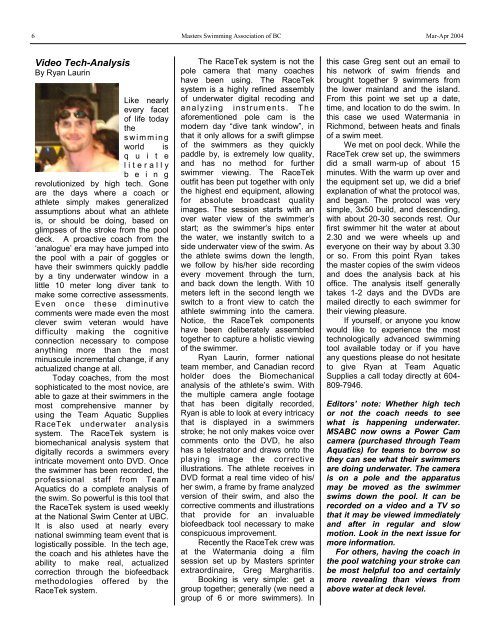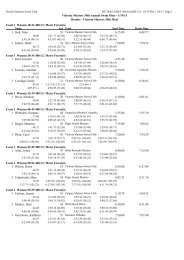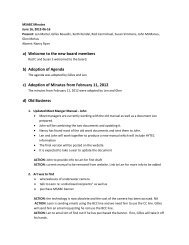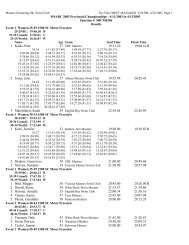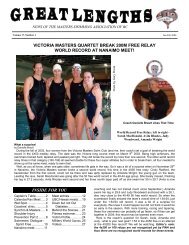Great Lengths - Masters Swimming Association of British Columbia
Great Lengths - Masters Swimming Association of British Columbia
Great Lengths - Masters Swimming Association of British Columbia
You also want an ePaper? Increase the reach of your titles
YUMPU automatically turns print PDFs into web optimized ePapers that Google loves.
6 <strong>Masters</strong> <strong>Swimming</strong> <strong>Association</strong> <strong>of</strong> BC<br />
Mar-Apr 2004<br />
Video Tech-Analysis<br />
By Ryan Laurin<br />
Like nearly<br />
every facet<br />
<strong>of</strong> life today<br />
the<br />
swimming<br />
world is<br />
q u i t e<br />
literally<br />
b e i n g<br />
revolutionized by high tech. Gone<br />
are the days where a coach or<br />
athlete simply makes generalized<br />
assumptions about what an athlete<br />
is, or should be doing, based on<br />
glimpses <strong>of</strong> the stroke from the pool<br />
deck. A proactive coach from the<br />
‘analogue’ era may have jumped into<br />
the pool with a pair <strong>of</strong> goggles or<br />
have their swimmers quickly paddle<br />
by a tiny underwater window in a<br />
little 10 meter long diver tank to<br />
make some corrective assessments.<br />
Even once these diminutive<br />
comments were made even the most<br />
clever swim veteran would have<br />
difficulty making the cognitive<br />
connection necessary to compose<br />
anything more than the most<br />
minuscule incremental change, if any<br />
actualized change at all.<br />
Today coaches, from the most<br />
sophisticated to the most novice, are<br />
able to gaze at their swimmers in the<br />
most comprehensive manner by<br />
using the Team Aquatic Supplies<br />
RaceTek underwater analysis<br />
system. The RaceTek system is<br />
biomechanical analysis system that<br />
digitally records a swimmers every<br />
intricate movement onto DVD. Once<br />
the swimmer has been recorded, the<br />
pr<strong>of</strong>essional staff from Team<br />
Aquatics do a complete analysis <strong>of</strong><br />
the swim. So powerful is this tool that<br />
the RaceTek system is used weekly<br />
at the National Swim Center at UBC.<br />
It is also used at nearly every<br />
national swimming team event that is<br />
logistically possible. In the tech age,<br />
the coach and his athletes have the<br />
ability to make real, actualized<br />
correction through the bi<strong>of</strong>eedback<br />
methodologies <strong>of</strong>fered by the<br />
RaceTek system.<br />
The RaceTek system is not the<br />
pole camera that many coaches<br />
have been using. The RaceTek<br />
system is a highly refined assembly<br />
<strong>of</strong> underwater digital recoding and<br />
analyzing instruments. The<br />
aforementioned pole cam is the<br />
modern day “dive tank window”, in<br />
that it only allows for a swift glimpse<br />
<strong>of</strong> the swimmers as they quickly<br />
paddle by, is extremely low quality,<br />
and has no method for further<br />
swimmer viewing. The RaceTek<br />
outfit has been put together with only<br />
the highest end equipment, allowing<br />
for absolute broadcast quality<br />
images. The session starts with an<br />
over water view <strong>of</strong> the swimmer’s<br />
start; as the swimmer’s hips enter<br />
the water, we instantly switch to a<br />
side underwater view <strong>of</strong> the swim. As<br />
the athlete swims down the length,<br />
we follow by his/her side recording<br />
every movement through the turn,<br />
and back down the length. With 10<br />
meters left in the second length we<br />
switch to a front view to catch the<br />
athlete swimming into the camera.<br />
Notice, the RaceTek components<br />
have been deliberately assembled<br />
together to capture a holistic viewing<br />
<strong>of</strong> the swimmer.<br />
Ryan Laurin, former national<br />
team member, and Canadian record<br />
holder does the Biomechanical<br />
analysis <strong>of</strong> the athlete’s swim. With<br />
the multiple camera angle footage<br />
that has been digitally recorded,<br />
Ryan is able to look at every intricacy<br />
that is displayed in a swimmers<br />
stroke; he not only makes voice over<br />
comments onto the DVD, he also<br />
has a telestrator and draws onto the<br />
playing image the corrective<br />
illustrations. The athlete receives in<br />
DVD format a real time video <strong>of</strong> his/<br />
her swim, a frame by frame analyzed<br />
version <strong>of</strong> their swim, and also the<br />
corrective comments and illustrations<br />
that provide for an invaluable<br />
bi<strong>of</strong>eedback tool necessary to make<br />
conspicuous improvement.<br />
Recently the RaceTek crew was<br />
at the Watermania doing a film<br />
session set up by <strong>Masters</strong> sprinter<br />
extraordinaire, Greg Margharitis.<br />
Booking is very simple: get a<br />
group together; generally (we need a<br />
group <strong>of</strong> 6 or more swimmers). In<br />
this case Greg sent out an email to<br />
his network <strong>of</strong> swim friends and<br />
brought together 9 swimmers from<br />
the lower mainland and the island.<br />
From this point we set up a date,<br />
time, and location to do the swim. In<br />
this case we used Watermania in<br />
Richmond, between heats and finals<br />
<strong>of</strong> a swim meet.<br />
We met on pool deck. While the<br />
RaceTek crew set up, the swimmers<br />
did a small warm-up <strong>of</strong> about 15<br />
minutes. With the warm up over and<br />
the equipment set up, we did a brief<br />
explanation <strong>of</strong> what the protocol was,<br />
and began. The protocol was very<br />
simple, 3x50 build, and descending,<br />
with about 20-30 seconds rest. Our<br />
first swimmer hit the water at about<br />
2.30 and we were wheels up and<br />
everyone on their way by about 3.30<br />
or so. From this point Ryan takes<br />
the master copies <strong>of</strong> the swim videos<br />
and does the analysis back at his<br />
<strong>of</strong>fice. The analysis itself generally<br />
takes 1-2 days and the DVDs are<br />
mailed directly to each swimmer for<br />
their viewing pleasure.<br />
If yourself, or anyone you know<br />
would like to experience the most<br />
technologically advanced swimming<br />
tool available today or if you have<br />
any questions please do not hesitate<br />
to give Ryan at Team Aquatic<br />
Supplies a call today directly at 604-<br />
809-7946.<br />
Editors’ note: Whether high tech<br />
or not the coach needs to see<br />
what is happening underwater.<br />
MSABC now owns a Power Cam<br />
camera (purchased through Team<br />
Aquatics) for teams to borrow so<br />
they can see what their swimmers<br />
are doing underwater. The camera<br />
is on a pole and the apparatus<br />
may be moved as the swimmer<br />
swims down the pool. It can be<br />
recorded on a video and a TV so<br />
that it may be viewed immediately<br />
and after in regular and slow<br />
motion. Look in the next issue for<br />
more information.<br />
For others, having the coach in<br />
the pool watching your stroke can<br />
be most helpful too and certainly<br />
more revealing than views from<br />
above water at deck level.


